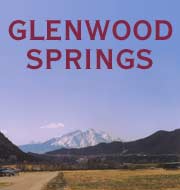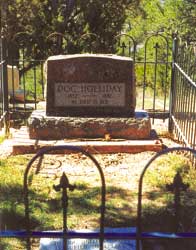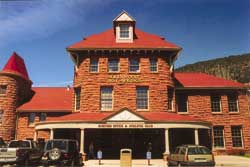|
|

Glenwood Springs
|
|
Colorado’s Hidden Jewel
|

Story and photos by Mark Swint
Quick, think of the Rockies! You thought of Colorado didn’t you? Of course you did! Thanks to John Denver and his "Rocky Mountain High" we all think of Colorado when we think of the Rockies. Fair enough. But where in Colorado do you think of? I’ll bet it is someplace chic and trendy like Aspen, Vail, or Breckenridge. These are places that have become synonymous with celebrity and beautiful people -- jet setters to be sure. But most of us don’t have jets, and most of us can’t afford the rarified prices that go along with Aspen’s rarefied air. Happily, Colorado’s Rockies hold more than a few jewels. Let me tell you about one lesser known, but remarkably lovely, that I recently happened upon.
Forty or so road miles northwest of Aspen on highway 70 towards Grand Junction, at the confluence of the Colorado River and the Roaring Fork River, sits the little, very picturesque, town of Glenwood Springs. A town not altogether unfamiliar with the notoriety and glamour of the world’s beautiful people, yet somewhat lost in the glare of its more famous neighbors, Aspen and Vail.
In 1860, a young government geologist named Captain Richard Sopris discovered the 3-way valley formed by the junction of the Colorado and the Roaring Fork Rivers. The area’s natural resources and spectacular beauty impressed him. It was, however, 20 years before a permanent settlement, originally called Defiance, was actually founded. In 1885 the fledgling town was renamed Glenwood Springs, after the town of Glenwood, Iowa, and soon it was hosting visitors from all over the country.
The reason for Glenwood Springs’ rise in popularity was its geothermal hot springs and the nearby vapor caves. For centuries, the Ute Indians had come to this valley in pursuit of the huge herds of deer and elk that found comfort at the springs. The Utes summered at the place they called Yampa. Yampa means Big Medicine, since the vapors and sulfur of the springs and caves were thought to be a curative for whatever ailed the body. Early settlers found similar comfort in the waters, and word quickly spread of this natural wonder. Almost immediately, people from far and wide began making the arduous journey here to find relief from their ailments.
 Perhaps the most infamous of these visitor to the area was John Henry "Doc" Holliday, who came to the springs in the fall of 1887 in a futile attempt to cure his consumption (tuberculosis). Marshall Wyatt Earp called Holliday "the most skillful gambler, and the nerviest, fastest, deadliest man with a six-gun I ever saw." Doc’s tuberculosis was too far advanced for any cure, and he died in Glenwood Springs in November of 1887. Nowadays there are signs leading to his grave, with a short but vigorous hike up the hill to the cemetery. His burial brought something of a mystery to the town. It was rumored that an eastern gang wanted his body, so a funeral was staged in which his casket, loaded with rocks, was buried. His body was actually buried under a house on 8th and Palmer. A few years later he was removed from the house and buried in the hillside cemetery that overlooks the town. A lovely marker commemorates his grave, though a sign explains that his exact resting-place in the cemetery is unknown. Another sign perpetuates the mystery of his whereabouts by revealing that a still living local resident knows the details and secret of his burial, but will not reveal it until "a promise is kept." No one seems to know what that promise, is so I guess for now we’ll just wait and see. Perhaps the most infamous of these visitor to the area was John Henry "Doc" Holliday, who came to the springs in the fall of 1887 in a futile attempt to cure his consumption (tuberculosis). Marshall Wyatt Earp called Holliday "the most skillful gambler, and the nerviest, fastest, deadliest man with a six-gun I ever saw." Doc’s tuberculosis was too far advanced for any cure, and he died in Glenwood Springs in November of 1887. Nowadays there are signs leading to his grave, with a short but vigorous hike up the hill to the cemetery. His burial brought something of a mystery to the town. It was rumored that an eastern gang wanted his body, so a funeral was staged in which his casket, loaded with rocks, was buried. His body was actually buried under a house on 8th and Palmer. A few years later he was removed from the house and buried in the hillside cemetery that overlooks the town. A lovely marker commemorates his grave, though a sign explains that his exact resting-place in the cemetery is unknown. Another sign perpetuates the mystery of his whereabouts by revealing that a still living local resident knows the details and secret of his burial, but will not reveal it until "a promise is kept." No one seems to know what that promise, is so I guess for now we’ll just wait and see.
In 1886, the Devereux brothers, along with a group of British investors, bought the hot springs and surrounding 10 acres from one of Capt. Sopris’ expedition members and an early settler, Captain Isaac Cooper, for $125,000. They had ambitious dreams, and their efforts to build the largest hot spring resort in the world became a massive undertaking. The first task was to divert the natural flow of the Colorado River to moderate the temperature and flow of the springs. Inmates from the city jail provided the labor to build the natural rock pile diversion, and soon the construction on the huge primary pool was begun. Eventually the efforts yielded a giant pool that measured 615’x 75’ and 3.5’ to 5.5’deep.
 Today this pool is kept at 90&Mac176; F, and is accompanied by another, smaller, pool that stays at a bone-warming 104&Mac176; F. The main pool flows at an impressive 3,500,000 gallons per day. A beautiful sandstone bathhouse and lodge accompany the whole complex. This structure was designed by a famous Viennese architect, and originally contained tubs and Roman vapor baths. It had 44 bathrooms, with a dressing and lounging room for each bath. Other facilities in the building made it a full service "spa" for visitors. Since those days the building has seen many changes, and you can obtain the full and fascinating history when you visit. A visit to the pools today will cost a very reasonable $9.50 per day. Today this pool is kept at 90&Mac176; F, and is accompanied by another, smaller, pool that stays at a bone-warming 104&Mac176; F. The main pool flows at an impressive 3,500,000 gallons per day. A beautiful sandstone bathhouse and lodge accompany the whole complex. This structure was designed by a famous Viennese architect, and originally contained tubs and Roman vapor baths. It had 44 bathrooms, with a dressing and lounging room for each bath. Other facilities in the building made it a full service "spa" for visitors. Since those days the building has seen many changes, and you can obtain the full and fascinating history when you visit. A visit to the pools today will cost a very reasonable $9.50 per day.
Another famous visitor, William "Buffalo Bill" Cody, also came to Glenwood Springs hoping for a cure for his terminal ailment. In 1917 Buffalo Bill came with his personal doctor for treatments, only to die 5 days later. Other noteworthy visitors to the springs included the Mayo Brothers, who visited before starting their famous clinic in Minnesota, and the "Unsinkable" Molly Brown, a famous survivor of the Titanic disaster. Molly visited Glenwood Springs often, hosting fashionable parties at the still beautiful Hotel Colorado.
The Hotel Colorado was finished in June of 1893, and instantly became the place to see and be seen. After President Teddy Roosevelt’s first visit in 1905, during his famous bear hunt, the hotel became known as the "Little White House of the United States." Other presidents, along with stars from the burgeoning movie industry, also started visiting the Hotel Coronado. Today the hotel (now a National Historic Landmark), retains its early elegance, and offers very reasonable rates and fine dining. A leisurely stroll through the main floor provides a wealth of history in the photos that adorn the walls. The hotel is well worth a visit, even if you are not staying the night.
During the twenties and thirties, the town and the springs became a favorite hangout for famous gangsters. Diamond Jack Alterie loved the area, and introduced it to his associate Al Capone. Diamond Jack even bought some land here, and planned to stay until an altercation at a local club left three people shot and Jack facing a choice of 5 years in prison or leaving the state. He chose the latter.
 To be sure, Glenwood Springs’ allure these days isn’t just its history or the hot springs. The area has a wealth of activities and resources to occupy just about anyone. Like its more famous neighbors, Glenwood Springs hosts its own ski area for both alpine and Nordic skiing. Sunlight Mountain Resort has a full winter season, with remarkably reasonable rates and a good variety of runs. The Nordic skiing season runs much longer into the spring up in this high country, and guided tours are available. In the summer, the surrounding White River National Forest provides miles of trails for hiking or mountain biking, and the Roaring Fork River has wonderful year round fly-fishing. A stop by Roaring Fork Outfitters confirmed what I have long heard, that fly-fishing in Colorado is as good as or better in the winter than in the summer. Other summertime activities include Horseback riding and guided river rafting. To be sure, Glenwood Springs’ allure these days isn’t just its history or the hot springs. The area has a wealth of activities and resources to occupy just about anyone. Like its more famous neighbors, Glenwood Springs hosts its own ski area for both alpine and Nordic skiing. Sunlight Mountain Resort has a full winter season, with remarkably reasonable rates and a good variety of runs. The Nordic skiing season runs much longer into the spring up in this high country, and guided tours are available. In the summer, the surrounding White River National Forest provides miles of trails for hiking or mountain biking, and the Roaring Fork River has wonderful year round fly-fishing. A stop by Roaring Fork Outfitters confirmed what I have long heard, that fly-fishing in Colorado is as good as or better in the winter than in the summer. Other summertime activities include Horseback riding and guided river rafting.
For those interested in less strenuous activities, a visit to the Fairy Caves would be an interesting side trip. These natural caverns were first discovered in the early 1880s. Tours started in 1886, and continued until World War I. Recently, the caves were reopened, and newly discovered sections of the caves were made available to the public. A two hour guided tour will take you to Exclamation Point, a cliff-side balcony providing panoramic views of the Glenwood Canyon. From there the tour continues deep into the mountain to sites such as The Barn, a 5-story room covered with unusual crystalline formations, and the fabulous King’s Row, a chamber lined entirely with spectacular stalactites and stalagmites.
The airport at Glenwood Springs can best be described as "funky." Rustic, eclectic, and unpretentious also come to mind. No haven for corporate G-Vs or personally flown Citations here. The airport is more reminiscent of some of the back woods working airstrips of Alaska or the North Country. Though paved, it is basic at best. The runway is 3300 feet long and only 50 feet wide, with narrower taxiways that were challenging even for my Baron. Clutter of every sort, from old airplanes to what looked like storage for county equipment and derelict machinery, crowded both sides. Thrown into the mix are weeds, a few houses, hangers of every ilk, abandoned cars, and other long-since forgotten stuff. This is not to say the airport is without its own particular charm! A lone self-serve gas pump stands sentinel in front of an unmanned but open office for Glenwood Airport. A sign on the door beckons the visitor in, with the invitation to use the facilities and a reminder to keep the place clean. Phone numbers for the operator as well as select car rental agencies are posted on the door.
The airport manager, Richard Weinberg, is a friendly former FAA Terminal Controller who worked several big cities before coming west. He managed both Aspen and Eagle airports before settling in Glenwood Springs a while back for an active retirement. He uses a few aircraft to provide mountain flying instruction and other flying services on an on-call basis. Dick, as his friends call him, loves the place, and one can instantly tell that he is in the business for the love of flying. Refreshing!
The same geology that makes Glenwood Springs so attractive and unique to visitors also adds to the challenge for the weekend pilot landing there. The city sits in the crux of a T-shaped valley where the two rivers converge. Hills all around, and a 5916’ airport elevation make this a true mountain airport, so prudent mountain flying techniques are required. The airstrip sits between steep hills along the Roaring Fork River just south of town, with a good long valley to the southeast. All things being equal, this approach up the valley to runway 32 is the best route to the airport. Leaving back out this same way on runway 14 is the best departure as well. This approach and departure route is also mandated by local ordinance to appease the ever-present noise sensitive neighbors, unless winds are more than 5 knots on the tail or other pilot safety considerations overrule. Though the southwest departure is upriver, the runway is, in fact, downhill very slightly.
As with most mountain or backcountry airstrips, Glenwood Springs provides justification for the adage "be on the ground by noon," since the winds begin to kick up about that time. The unique triangular mountain arrangement that forms the valley breeds some strange winds, which can swirl and gust with no discernable pattern. Within a few minutes, the wind can swing around several times. On an average day this shouldn’t be too much of a problem, other than a bumpy ride in and out. The greater concern is performance and density altitude. At an elevation of over 5900 feet, it is easy to imagine how the density altitudes can quickly climb. Pilots should consult the aircraft POH before departing. Having said that, I should point out that most types of planes were represented at Glenwood Springs on the occasion that I visited. The path out of the valley in either direction is fairly clear and unobstructed, so patience with no expectation of a rapid climb-out will eventually get you above the mountains. Dick told me the biggest problem they have had over the years is from pilots who seemed bent on getting the same performance out of their planes at Glenwood that they expect at lower elevation fields. There is nothing to hit after takeoff, so patience and an eye on the airspeed should get you out just fine.
As with most of Colorado, the weather can change very quickly so a visit shouldn’t be made with a rigid schedule. Keep an eye on the weather and the winds and plan your departure accordingly. Patience and prudence can make all the difference in the success of your trip. Besides, how tough can it be getting stuck in a place so beautiful and with so much to see and do as Glenwood Springs!
|
 |
FLYING TO GLENWOOD SPRINGS
Glenwood Springs (GWS) is on the Denver sectional at Lat/Long N39.30.5 W107.18.7. It has an RNAV fix off of DBL VOR (Red Table) 113.0 at 270º 19.8DME. This is a daylight only airport with no instrument approach. Communications are on 122.8, which is a "Super Unicom," automatically broadcasting updated AWOS info as it changes. With winds so variable here during the afternoon, the constant updates are a great feature. The preferred runway is 32 for approach and 14 for departure.
Rental cars are available off airport, but a call ahead of time will definitely speed things up. Enterprise car rental helped us. They have an office right in Glenwood Springs, and though they had to pick us up and take us to the office to rent the car, we were able to drop it off at the field on departure (970-384-2460). The local Ford dealership has a Hertz franchise, and will also be happy to come get you (970-945-7362). Additionally, Silver Wheels Rent-A-Car is a small independent with, generally, the best rates (970-945-7107).
For further information before you go, contact the airport manager, Dick Weinberg, by e-mail at Weinberg@rof.net, or call him at 970-618-0778. |
Mark Swint is a senior captain for United airlines, flying 767 and 757 aircraft based in LAX. For fun, he flies his Cessna C-185 and Beech Baron B-55. Mark has been a writer for many years, including a two-year stint in Hollywood and London working in the screenwriting business.
|
Click here to return to the beginning of this article.  |
|